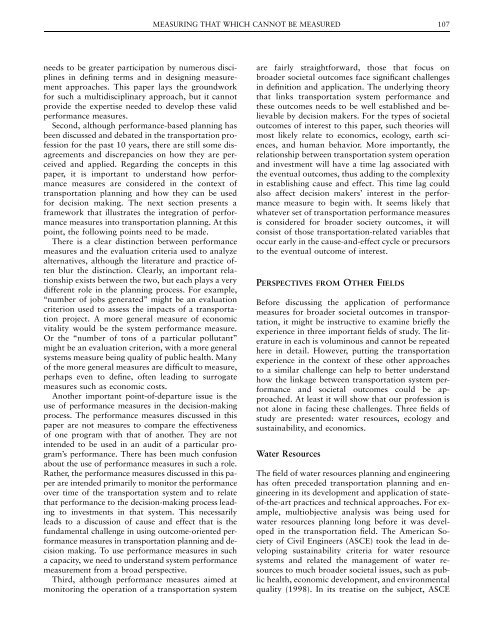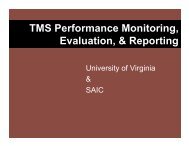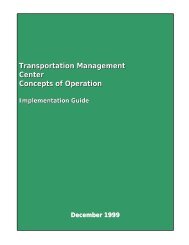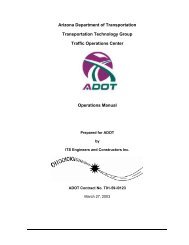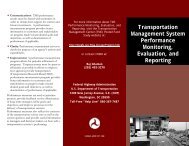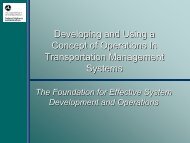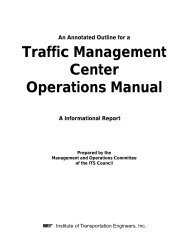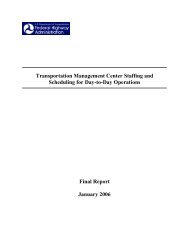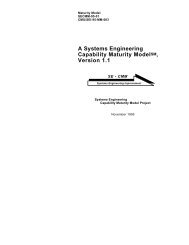106 PERFORMANCE MEASURES TO IMPROVE TRANSPORTATION SYSTEMS AND AGENCY OPERATIONSFIGURE 1Hierarchy of decision making. (SDOT = state department of transportation.)strategic investment decisions. At each level, performancemeasures and corresponding data can be usedto provide feedback to the relevant decisions. However,the vertical arrows represent data or performancemeasures that can be used at higher decisionmakinglevels. The dashed arrows reflect suchmeasures or data that transcend all levels of decisionmaking and provide input into decision making atthe strategic investment decision-making level (thus,at least conceptually, answering one of the questionspreviously raised). However, at each level, therecould be measures desired by the corresponding decisionmakers that are specific to that decision context.These measures are represented by the horizontalarrows in Figure 1. At the very highest level, thiscould imply that decision makers might be interestedin issues and performance measures not directlylinked to information surfacing from the other levels,for example, impacts on economic productivity, environmentaljustice, and quality of life. The desire forthis type of information would result in a top-downdirection to planners and analysts to produce the requestedinformation as part of the decision-makingprocess.This framework also allows one to characterizeperformance measurement along several dimensionsthat become important in the discussion of how crediblemeasurement can take place. As shown in Figure1, for example, the hierarchy of decision making suggeststhat at the operations level, performance measurementwould tend to occur at the local level, focusmore on outputs where the cause-and-effect relationshipbetween changes in the transportation systemand resulting performance characteristics is more direct,and where data can be collected and used on ashort-term basis. At the top of the triangle, performancemeasurement would have a much broaderscope. It would be likely to focus on outcomes inwhich indirect cause-and-effect relationships mightplay an important role, and in which data on resultingchanges might have significant time lags associatedwith it. All of these characteristics become criticalconsiderations in answering the questions posedin the introduction of this paper.Three important qualifying statements need to bemade. First, the types of societal outcomes of interestto transportation decision makers would probablyrequire expertise beyond what can possibly be providedby one individual. Ecosystem health, for example,deserves the attention of ecologists, biologists,and environmental scientists. Similarly, economicwell-being is the purview of economists, sociologists,and political scientists—none of whom would belikely to agree on a common definition of well-being.Thus, as transportation planning becomes moreclosely related to broadly defined policy goals, there
MEASURING THAT WHICH CANNOT BE MEASURED 107needs to be greater participation by numerous disciplinesin defining terms and in designing measurementapproaches. This paper lays the groundworkfor such a multidisciplinary approach, but it cannotprovide the expertise needed to develop these validperformance measures.Second, although performance-based planning hasbeen discussed and debated in the transportation professionfor the past 10 years, there are still some disagreementsand discrepancies on how they are perceivedand applied. Regarding the concepts in thispaper, it is important to understand how performancemeasures are considered in the context oftransportation planning and how they can be usedfor decision making. The next section presents aframework that illustrates the integration of performancemeasures into transportation planning. At thispoint, the following points need to be made.There is a clear distinction between performancemeasures and the evaluation criteria used to analyzealternatives, although the literature and practice oftenblur the distinction. Clearly, an important relationshipexists between the two, but each plays a verydifferent role in the planning process. For example,‘‘number of jobs generated’’ might be an evaluationcriterion used to assess the impacts of a transportationproject. A more general measure of economicvitality would be the system performance measure.Or the ‘‘number of tons of a particular pollutant’’might be an evaluation criterion, with a more generalsystems measure being quality of public health. Manyof the more general measures are difficult to measure,perhaps even to define, often leading to surrogatemeasures such as economic costs.Another important point-of-departure issue is theuse of performance measures in the decision-makingprocess. The performance measures discussed in thispaper are not measures to compare the effectivenessof one program with that of another. They are notintended to be used in an audit of a particular program’sperformance. There has been much confusionabout the use of performance measures in such a role.Rather, the performance measures discussed in this paperare intended primarily to monitor the performanceover time of the transportation system and to relatethat performance to the decision-making process leadingto investments in that system. This necessarilyleads to a discussion of cause and effect that is thefundamental challenge in using outcome-oriented performancemeasures in transportation planning and decisionmaking. To use performance measures in sucha capacity, we need to understand system performancemeasurement from a broad perspective.Third, although performance measures aimed atmonitoring the operation of a transportation systemare fairly straightforward, those that focus onbroader societal outcomes face significant challengesin definition and application. The underlying theorythat links transportation system performance andthese outcomes needs to be well established and believableby decision makers. For the types of societaloutcomes of interest to this paper, such theories willmost likely relate to economics, ecology, earth sciences,and human behavior. More importantly, therelationship between transportation system operationand investment will have a time lag associated withthe eventual outcomes, thus adding to the complexityin establishing cause and effect. This time lag couldalso affect decision makers’ interest in the performancemeasure to begin with. It seems likely thatwhatever set of transportation performance measuresis considered for broader society outcomes, it willconsist of those transportation-related variables thatoccur early in the cause-and-effect cycle or precursorsto the eventual outcome of interest.PERSPECTIVES FROM OTHER FIELDSBefore discussing the application of performancemeasures for broader societal outcomes in transportation,it might be instructive to examine briefly theexperience in three important fields of study. The literaturein each is voluminous and cannot be repeatedhere in detail. However, putting the transportationexperience in the context of these other approachesto a similar challenge can help to better understandhow the linkage between transportation system performanceand societal outcomes could be approached.At least it will show that our profession isnot alone in facing these challenges. Three fields ofstudy are presented: water resources, ecology andsustainability, and economics.Water ResourcesThe field of water resources planning and engineeringhas often preceded transportation planning and engineeringin its development and application of stateof-the-artpractices and technical approaches. For example,multiobjective analysis was being used forwater resources planning long before it was developedin the transportation field. The American Societyof Civil Engineers (ASCE) took the lead in developingsustainability criteria for water resourcesystems and related the management of water resourcesto much broader societal issues, such as publichealth, economic development, and environmentalquality (1998). In its treatise on the subject, ASCE
- Page 5 and 6:
National Academy of SciencesNationa
- Page 7 and 8:
Workshop Summary ..................
- Page 9:
General OverviewIntroductionExecuti
- Page 12 and 13:
4 PERFORMANCE MEASURES TO IMPROVE T
- Page 14 and 15:
6 PERFORMANCE MEASURES TO IMPROVE T
- Page 18 and 19:
10 PERFORMANCE MEASURES TO IMPROVE
- Page 20 and 21:
12 PERFORMANCE MEASURES TO IMPROVE
- Page 23:
Linking Performance Measures withDe
- Page 26 and 27:
18 PERFORMANCE MEASURES TO IMPROVE
- Page 28 and 29:
20 PERFORMANCE MEASURES TO IMPROVE
- Page 30 and 31:
22 PERFORMANCE MEASURES TO IMPROVE
- Page 32 and 33:
24 PERFORMANCE MEASURES TO IMPROVE
- Page 34 and 35:
26 PERFORMANCE MEASURES TO IMPROVE
- Page 36 and 37:
28 PERFORMANCE MEASURES TO IMPROVE
- Page 38 and 39:
30 PERFORMANCE MEASURES TO IMPROVE
- Page 40 and 41:
32 PERFORMANCE MEASURES TO IMPROVE
- Page 42 and 43:
Panel DiscussionJohn Poorman, Capit
- Page 44 and 45:
36 PERFORMANCE MEASURES TO IMPROVE
- Page 46 and 47:
38 PERFORMANCE MEASURES TO IMPROVE
- Page 48 and 49:
Workshop SummaryJohn Basilica, Loui
- Page 50 and 51:
42 PERFORMANCE MEASURES TO IMPROVE
- Page 52 and 53:
44 PERFORMANCE MEASURES TO IMPROVE
- Page 55 and 56:
RESOURCE PAPERImplementing Performa
- Page 57 and 58:
IMPLEMENTING PERFORMANCE MEASUREMEN
- Page 59 and 60:
IMPLEMENTING PERFORMANCE MEASUREMEN
- Page 61 and 62:
IMPLEMENTING PERFORMANCE MEASUREMEN
- Page 63 and 64: IMPLEMENTING PERFORMANCE MEASUREMEN
- Page 65 and 66: IMPLEMENTING PERFORMANCE MEASUREMEN
- Page 67 and 68: Panel DiscussionJennifer Finch, Col
- Page 69 and 70: FIGURE 2Level of measures and align
- Page 71 and 72: PANEL DISCUSSION: AGENCY IMPLEMENTA
- Page 73 and 74: PANEL DISCUSSION: AGENCY IMPLEMENTA
- Page 75 and 76: PANEL DISCUSSION: AGENCY IMPLEMENTA
- Page 77 and 78: PANEL DISCUSSION: AGENCY IMPLEMENTA
- Page 79 and 80: WORKSHOP SUMMARY: AGENCY IMPLEMENTA
- Page 81: Selecting Measures, Data Needs, and
- Page 84 and 85: 76 PERFORMANCE MEASURES TO IMPROVE
- Page 86 and 87: 78 PERFORMANCE MEASURES TO IMPROVE
- Page 88 and 89: 80 PERFORMANCE MEASURES TO IMPROVE
- Page 90 and 91: 82 PERFORMANCE MEASURES TO IMPROVE
- Page 92 and 93: 84 PERFORMANCE MEASURES TO IMPROVE
- Page 94 and 95: 86 PERFORMANCE MEASURES TO IMPROVE
- Page 96 and 97: Panel Discussion, Part 1Anita Vande
- Page 98 and 99: 90 PERFORMANCE MEASURES TO IMPROVE
- Page 100 and 101: 92 PERFORMANCE MEASURES TO IMPROVE
- Page 102 and 103: Panel Discussion, Part 2Douglas Zim
- Page 104 and 105: FIGURE 11 Example data
- Page 106 and 107: 98 PERFORMANCE MEASURES TO IMPROVE
- Page 108 and 109: Workshop SummaryBrenda Berg, Trans
- Page 110 and 111: 102 PERFORMANCE MEASURES TO IMPROVE
- Page 113: RESOURCE PAPERMeasuring That Which
- Page 117 and 118: TABLE 1Sustainability MeasuresNewma
- Page 119 and 120: MEASURING THAT WHICH CANNOT BE MEAS
- Page 121 and 122: MEASURING THAT WHICH CANNOT BE MEAS
- Page 123 and 124: MEASURING THAT WHICH CANNOT BE MEAS
- Page 125 and 126: MEASURING THAT WHICH CANNOT BE MEAS
- Page 127 and 128: MEASURING THAT WHICH CANNOT BE MEAS
- Page 129 and 130: MEASURING THAT WHICH CANNOT BE MEAS
- Page 131 and 132: MEASURING THAT WHICH CANNOT BE MEAS
- Page 133 and 134: MEASURING THAT WHICH CANNOT BE MEAS
- Page 135 and 136: PANEL DISCUSSION: CONNECTING SYSTEM
- Page 137 and 138: PANEL DISCUSSION: CONNECTING SYSTEM
- Page 139 and 140: PANEL DISCUSSION: CONNECTING SYSTEM
- Page 141 and 142: PANEL DISCUSSION: CONNECTING SYSTEM
- Page 143 and 144: Workshop SummaryScott Bassett, Oreg
- Page 145: Freight Performance MeasuresCurrent
- Page 148 and 149: 140 PERFORMANCE MEASURES TO IMPROVE
- Page 150 and 151: 142 PERFORMANCE MEASURES TO IMPROVE
- Page 152 and 153: 144 PERFORMANCE MEASURES TO IMPROVE
- Page 154 and 155: 146 PERFORMANCE MEASURES TO IMPROVE
- Page 156 and 157: 148 PERFORMANCE MEASURES TO IMPROVE
- Page 158 and 159: 150 PERFORMANCE MEASURES TO IMPROVE
- Page 160 and 161: 152 PERFORMANCE MEASURES TO IMPROVE
- Page 163 and 164: APPENDIX ASummaries of 20 Poster Se
- Page 165 and 166:
SUMMARIES OF 20 POSTER SESSIONS 157
- Page 167 and 168:
TABLE 1(continued) WSDOT Outcomes,
- Page 169 and 170:
SUMMARIES OF 20 POSTER SESSIONS 161
- Page 171 and 172:
SUMMARIES OF 20 POSTER SESSIONS 163
- Page 173 and 174:
SUMMARIES OF 20 POSTER SESSIONS 165
- Page 175 and 176:
SUMMARIES OF 20 POSTER SESSIONS 167
- Page 177 and 178:
FIGURE 2 Sacramento Regional Transi
- Page 179 and 180:
FIGURE 3Goal evaluation table: Chit
- Page 181 and 182:
SUMMARIES OF 20 POSTER SESSIONS 173
- Page 183 and 184:
SUMMARIES OF 20 POSTER SESSIONS 175
- Page 185 and 186:
SUMMARIES OF 20 POSTER SESSIONS 177
- Page 187 and 188:
TABLE 6Mobility Performance Measure
- Page 189 and 190:
SUMMARIES OF 20 POSTER SESSIONS 181
- Page 191 and 192:
SUMMARIES OF 20 POSTER SESSIONS 183
- Page 193 and 194:
SUMMARIES OF 20 POSTER SESSIONS 185
- Page 195 and 196:
FIGURE 13 MPAH lane-miles by roadwa
- Page 197 and 198:
SUMMARIES OF 20 POSTER SESSIONS 189
- Page 199 and 200:
SUMMARIES OF 20 POSTER SESSIONS 191
- Page 201 and 202:
SUMMARIES OF 20 POSTER SESSIONS 193
- Page 203 and 204:
SUMMARIES OF 20 POSTER SESSIONS 195
- Page 205 and 206:
SUMMARIES OF 20 POSTER SESSIONS 197
- Page 207 and 208:
SUMMARY OF PEER EXCHANGE ON DATA FO
- Page 209 and 210:
SUMMARY OF PEER EXCHANGE ON DATA FO
- Page 211 and 212:
SUMMARY OF PEER EXCHANGE ON DATA FO
- Page 213 and 214:
SUMMARY OF PEER EXCHANGE ON DATA FO
- Page 215 and 216:
SUMMARY OF PEER EXCHANGE ON DATA FO
- Page 217 and 218:
SUMMARY OF PEER EXCHANGE ON DATA FO
- Page 219 and 220:
SUMMARY OF PEER EXCHANGE ON DATA FO
- Page 221 and 222:
SUMMARY OF PEER EXCHANGE ON DATA FO
- Page 223 and 224:
APPENDIX C: RESEARCH STATEMENTS DEV
- Page 225 and 226:
LIST OF PARTICIPANTS 217University,
- Page 227:
LIST OF PARTICIPANTS 219Darwin Stua


